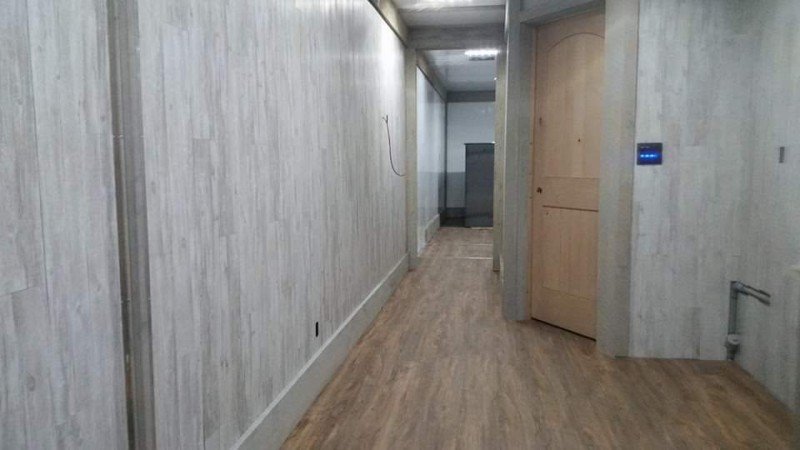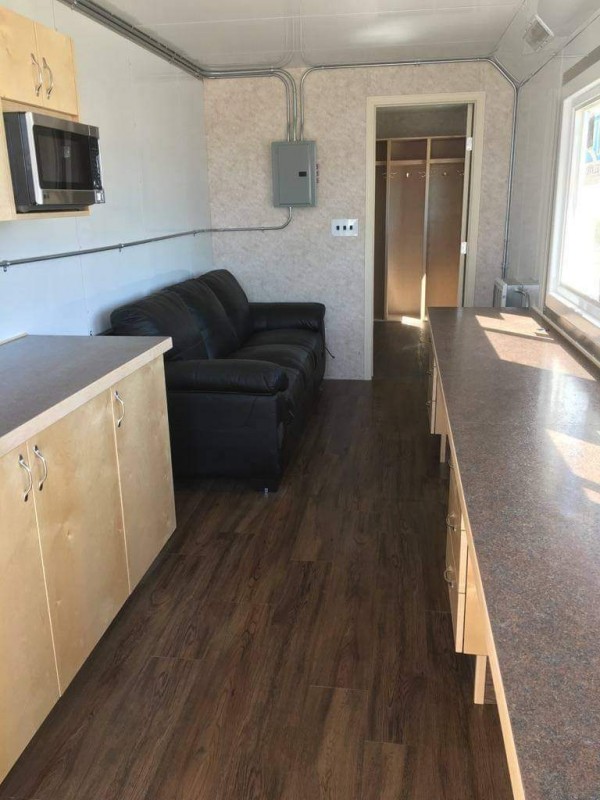There are many ways to repurpose a new or used shipping container. Some container enthusiasts have repurposed them as very simple homes or cabins, others into very elaborate multi container abodes. They make great work shops, garages, and even kiosks for food or retail services. Shipping containers offer a solid foundation to build off of and for the highly creative, they are a blank canvas to create something functional or spectacular. If you have the right tools, modifications are simple, and the end product remains strong and weatherproof. Sections can be cut and removed, doors and windows added, and accessories can be installed according to the needs of the enthusiast. Having access to welding and steel cutting equipment obviously makes this task simpler. Here are some ideas on simple container modification.

This lake house container was insulated with foam core 1.5″ panels and then a portion was covered and finished with vinyl planks for a rustic feel
Insulating a shipping container
There are a few different methods to container insulating. Containers can be internally or externally insulated. Some modifications are done with a basic 2 x 2 wood frame internally and then sheets of 2″ Styrofoam insulation is inserted between the framing and the finished wall is sheeted with vinyl panels or drywall. Similarly a spray foam can be applied between the framing and then covered. There are also manufacturers of foam core metal panel systems that come in varying thicknesses, commonly 1.5″ or 2″ that can be installed with an aluminum channel extrusion system. The disadvantage to interior insulating is you lose a portion of the container width, generally 4″. To insulate floor and ceiling similar methods can be utilized. Spray foam works exceptionally well under a container floor and is simple to apply if the container can be elevated on stands. Spray foam can either be installed by a contractor or do it yourself spray foam kits are also available. Generally R12-R16 value is sufficient to keep things cool in the summer and toasty in the colder months.
Flooring
Flooring is very simple and easy to install in a container conversion. Almost any residential or commercial flooring options can be used. Linoleum, vinyl, even carpet can be utilized. Floor bonding methods such as glue or adhesives go on very well and can be installed directly onto an existing clean surface. Vinyl strip is an excellent flooring choice as it’s available in many different grades and patterns, it’s also extremely durable and slip resistant. A cold weather based adhesive troweled on prior to laying the vinyl allows for a good bond which will keep the flooring in place is the container needs to be relocated. If the container has partitions or separate rooms different flooring can be installed throughout as desired.

This shipping container office conversion features insulated wall paneling, vinyl strip flooring, and surface mounted conduit for the electrical
Electrical
Installing electrical in a container can be tricky. Optimally it’s preferential to have wiring hidden where possible. If the interior is framed, wiring can be run neatly in the framing and receptacles and fixtures can be installed where the wall corrugation extrudes outwards. BX wiring is preferential. If you have partition walls breaker panels and other ancillary items can be installed in partitions. Overhead lighting can be attached to framing if the ceiling is framed. Another option if the building isn’t framed is to run surface conduit attached to the container. The conduit can be painted, or left bare for an industrial style look and feel.
Exterior
Generally when a sea can is modified there is a lot of cutting and welding. Doors and windows need to be installed, appliances such as air conditioning or heating lines require cutouts, and plumbing may also need to be run through exterior walls. When there is extensive cutting and welding the container paint will be ground off or burnt, so after your container is modified and ready for finishing an exterior coating of paint will need to be applied. Paint should be suitable for metals, and for the best results the exterior should be sandblasted, primed, and coated with a 2 part epoxy, such as Endura. It’s an expensive finish, but it will last for years if it’s properly applied. Coatings should be able to withstand the elements and UV light. A 2 part rock guard coating can also be applied for industrial grade results.
HVAC
To keep your container warm in the winter and cool in the summer heating and air conditioning are a must. A natural gas furnace can be utilized if gas is available. If there is no gas supply or the unit is portable propane is also an option. Ducting can be either hidden in a framed ceiling, although you will require a drop down space, this works well in high cube containers. If there is no ceiling space ducting can be attached directly to the container ceiling. Air conditioning can be roof top, like an RV style air conditioner, or optionally a through wall cutout can be made and a through wall AC unit can be installed. Ensure that the unit if properly sealed to avoid having water or insects coming into the unit through any gaps. If rooftop AC is installed the same applies, it must be well sealed to avoid any potential leaks.

An emaciating pump out toilet works great in a shipping container washroom as there is no requirement for plumbing under the fixture
Plumbing
Just like electrical shipping container plumbing installation can also be a challenge. If the container is installed in a permanent location a septic field or exterior buried tank can be installed. If fresh water supply is required an interior tank and pressure system can be utilized or a buried cistern can also be used if the container is staying in one location. water lines and drains should be hidden in partition walls, ceilings, or framing where possible. An excellent toilet option for a container is an emaciating pump out toilet. There is no requirement for plumbing under this style of toilet, the base of the toilet pumps waste out vertically to a holding tank. A sink can also be plumbed to the toilet base for pump out. This system works great for portable self contained systems on a container that will be moved around to various locations.
In summary there are many other things to consider on any container modification project. Ideas are limitless and creativity is the key to solving any challenges that may arise. The end result should strive be be fully functional and suit the purpose of what’s need. Most home building materials readily available can be used in a shipping container. If you have a conversion idea and need a shipping container delivered please give Heath Specialty Services a shout and we will be happy to assist you.

